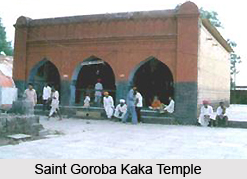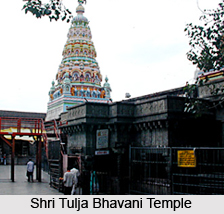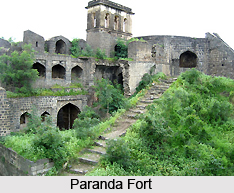 Tourism in Osmanabad district is a packed trip. There are a number of places that the tourist can visit, both of religious significance as well as leisurely interest. For the pilgrims visiting the district, there are temples such as the Shri Tulja Bhavani Temple and the Saint Goroba Kaka Temple. Also located here is a rather holy site for the followers of Jainism, the Shri Digambar Jain Sidhkshetra Kuntalgiri. This is a site said to have been made holy by the brothers Kulbhushan and Deshbhushan, who had offered tapasya here for the transformation of the soul. Among other attractions, the district offers the Dharashiv Caves, the Naldurg Fort and the Paranda Fort. All these places of tourist interest in Osmanabad district are discussed below.
Tourism in Osmanabad district is a packed trip. There are a number of places that the tourist can visit, both of religious significance as well as leisurely interest. For the pilgrims visiting the district, there are temples such as the Shri Tulja Bhavani Temple and the Saint Goroba Kaka Temple. Also located here is a rather holy site for the followers of Jainism, the Shri Digambar Jain Sidhkshetra Kuntalgiri. This is a site said to have been made holy by the brothers Kulbhushan and Deshbhushan, who had offered tapasya here for the transformation of the soul. Among other attractions, the district offers the Dharashiv Caves, the Naldurg Fort and the Paranda Fort. All these places of tourist interest in Osmanabad district are discussed below.
Pilgrimage Tourism in Osmanabad District
Saint Goroba Kaka Temple
Saint Goroba was born in Ter(Dhoki) in the year 1267. Hence this village is popular and known as `Goroba Ter`. The temple of Saint Goroba is one of the major attractions for the tourists and pilgrims visiting Osmanabad district. The temple was built in the 13th century after the death of Saint Goroba in 1317. This temple is square-shaped and constructed fully with stone. It is one of the best architectural models. There is also a Sabha Mandao here to perform religious and cultural activities.
Shri Digambar Jain Sidhkshetra Kuntalgiri
Kuntalgiri is one of the holy places of the Digambar Jain Sidhakshetras of south India. It is the land of Kulbhushan and Deshbhushan saints. During the period of twentieth Tirthankara Munisuvratnath, two brothers, Kulbhushan and Deshbhushan, had offered sustained prayer (Tapashcharya) for the transformation of the soul towards the almighty and thus made this place holy.
Shri Tulja Bhavani Temple
The second among the Shaktipeeths in India is the Tulja Bhavani of Tuljapur. It was the family deity of the Bhosale kings. Chatrapati Shivaji always visited the temple to seek her blessings. It is believed that the Goddess gifted him a sword - `the Bhawani sword` - for success in his expeditions. The history of the temple has been mentioned in the Skanda Puran. The temple is located on the hill of the Balaghat. The same place is today known as Tuljapur. The Idol of the Shree Tulja Bhavani mata is a swayambu idol. The goddess has eight hands and is seen sitting on a throne. There are two main entrances to get into the temple. One is called the Raja Shahaji Mahadwar, and the other is the Rajmata Jijavu main gate.
Among the Annual programs celebrated in the temple are:
Chaitra Purnima Utsav: Every year on the day of `Purnima` in the month of `Chaitra` this Utsav is held. In the same month a Mela is held at Shikhar-Shingnapur in the honour of Shambu Mahadev.
Shakambhari Navaratri utsav:- Every year in the month of `Paush` this utsav is held in the honour of the Shakambhari Devi of Badami, Karnataka.
Sharadiya Navaratri Utsav:- This utsav is held every year in the month of Ashwin.
Leisure Tourism in Osmanabad District
Dharashiv Caves
The Dharashiv caves are situated 8 Kms away from Osmanabad city in Balaghat mountains. There are a total of 7 caves in the Balaghat Mountain range. The first cave is without any statue with a small open space .The second cave consists of a statue with artistic work on the right side of the statue. The art work is of the Gandharva era. The fourth cave is an open space without any statue inside. The statue in the sixth cave is damaged while the seventh cave has no statue.
That this is an ancient place is shown by the caves excavated in the hill at a distance of about eight miles. These caves were originally Buddhist, but were later converted into monuments of the Jain religion and fresh caves were also excavated nearby. There are some more Buddhist caves that have been excavated in the hills, about 8 miles from Dharashiva. The earliest of them probably belongs to the 7th century AD. Cave No. II is modelled on the plan of the Vakataka cave at Ajanta caves. It has a central hall measuring 80 feet by 80 feet, with 14 cells for the residence of the Bhiksus and garbhagriha with a colossal image of Lord Buddha in Padmasana. From the hoods of a serpent spread over its head, it is supposed to be the image of the Jaina Tirthankara Parasvanatha, but the figures of deer with a dharmacakra between them on the pedestal indicates that it is that of Gautama Buddha. As per the historical survey of caves they were built in the 5th century B.C.
Naldurg
Naldurg, which was formerly a district headquarters, is situated about 50 Kms. south-east of Osmanabad. The fort has enclosed a surface of a knoll or plantain of basalt rock which juts out into the valley of the small Bori River. Along the rest of the cliff on three sides ran fortifications. The bastions are firmly built and are large enough to carry heavy guns. The entire circumference is about a mile and a half. The interior is covered with ruined walls and a vide road running up to the centre. The fort has many bastions amongst which are Upli Buruj, which is the high point in the fort , Paranda Buruj , Nagar Buruj, Sangam Buruj, Sangram Buruj etc. Inside the fort there are remains of the walls and some of the buildings such a Barood kotha, Baradari, Ambarkhana, Rangaan mahal, Jali etc. Though the buildings are in ruins the remains give a impression that there night have been at one time rather spacious buildings. The hathi Darwaza and the Hurmukh darwaza are the main gates of the fort. The most interesting building which connects the fort and the Ranmandala is the dam constructed across the Bori River. The fort is said to have been originally built by a Hindu Raja who was a vassal of the Chalukyas of Kalyani. It was later included in the dominions of the Bahamani dynasty and was subsequently taken over by the Adil shahi dynasty of Bijapur , from whom it passed into the hands of the Mughal dynasty in 1686 AD.
Paranda Fort
Paranda is situated about 80 Kms. from the district headquarters. The fort is one of many forts constructed by the Bahamani kings and is a fine specimen of military architecture and engineering. The gates are defended by traversals, redoubts and the ramparts. Around the fort there is a moat, which was always kept filled with water. The fort can be reached by only one passage. Inside the fort here are 26 bastions amongst which the note-worthy ones are "Mahakal Buruj" "Buruj Mahakal," Buland Buruj," Chanchal Buruj," and "Shah Mathkal." On some of the bastions there are old guns, the most important of which are the "Malike Maiden", and "Azda Paikar". The great bronze gun viz. the Malika Maiden now at Bijapur, is side to have been originally mounted here. At present inside the fort there are the mosque, Narsimaha Mandir, remains of the buildings like baradari, taikhana. Zanana makan etc. The remains of the walls and the dilapidated remains give an impression that at one time these might have been spacious and exquisite constructions.
These are the various places of tourism located in the district of Osmanabad.






